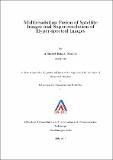Please use this identifier to cite or link to this item:
http://drsr.daiict.ac.in//handle/123456789/293| Title: | Multiresolution fusion of satellite images and super-resolution of hyper-spectral images |
| Authors: | Joshi, Manjunath V. Shripat, Abhishek Kumar |
| Keywords: | Particle swarm optimization Image processing Computer graphics Image processing Digital techniques Mathematical models Markov random fields Fusion Multisensor Multiresolution |
| Issue Date: | 2010 |
| Publisher: | Dhirubhai Ambani Institute of Information and Communication Technology |
| Citation: | Shripat, Abhishek Kumar (2010). Multiresolution fusion of satellite images and super-resolution of hyper-spectral images. Dhirubhai Ambani Institute of Information and Communication Technology, x, 46 p. (Acc.No: T00256) |
| Abstract: | This thesis presents a model based approach for multi-resolution fusion of the satellite images. Given a high resolution panchromatic (Pan) image and a low spatial but high spectral resolution multi spectral (MS) image acquired over the same geographical area, the objective is to obtain a high spatial resolution MS image. To solve this problem, maximum a posteriori (MAP) - Markov random field (MRF) based approach is used. Each of the low spatial resolution MS images are modeled as the aliased and noisy versions of their high resolution versions. The high spatial resolution MS images to be estimated are modeled separately as discontinuity preserving MRF that serve as prior information. The MRF parameters are estimated from the available high resolution Pan image using homotopy continuation method. The proposed approach has the advantage of having minimum spectral distortion in the fused image as it does not directly operate on the Pan digital numbers. This method does not require registration of MS and Pan images. Also the number of MRF parameters to be estimated from the Pan image is limited as homogeneous MRF is used. The time complexity of the approach is reduced by using the particle swarm optimization (PSO) in order to minimize the final cost function. The effectiveness of the approach is demonstrated by conducting experiments on real image captured by Landsat-7 ETM+ Satellite. <p/>This thesis also presents the Super-resolution of Hyper-spectral satellite images using Discrete Wavelet Transform based (DWT) learning. Given low resolution hyper spectral images and a data base consisting of sets of LR and HR textured images and satellite images; super-resolution of the hyper spectral image is obtained. Four hyper spectral test images are selected from 224 bands of hyper-spectral images through principal component analysis (PCA) technique. Using minimum absolute difference (MAD) criterion the best match wavelet coefficients are obtained. The finer details of test image are learned from the high resolution wavelet coefficients of the training data set. The inverse wavelet transform gives super resolved image corresponding to the test image. The effectiveness of above approach is demonstrated by conducting experiments on real Hyper-spectral images captured by Airborne Visible Infrared Imaging Spectrometer (AVIRIS). |
| URI: | http://drsr.daiict.ac.in/handle/123456789/293 |
| Appears in Collections: | M Tech Dissertations |
Files in This Item:
| File | Description | Size | Format | |
|---|---|---|---|---|
| 200811020.pdf Restricted Access | 945.25 kB | Adobe PDF |  View/Open Request a copy |
Items in DSpace are protected by copyright, with all rights reserved, unless otherwise indicated.
